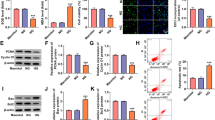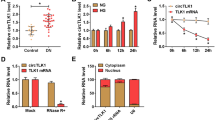Abstract
Human kidney cell injury is a representative characteristic of diabetic nephropathy (DN), and its development has been shown to be associated with the dysregulation of some circular RNAs (circRNAs). We thus explored the role of circ_0008529 in DN-conditioned human kidney cell injury. Human kidney cells (HK-2) were treated with high glucose (HG) to construct DN models in vitro. Quantitative real-time PCR (qPCR) assay and western blot assay were used for expression detection of circ_0008529, miR-485-5p, and Wnt family member 2B (WNT2B). Cell viability was ascertained by CCK-8 assay. Cell apoptosis was assessed by flow cytometry assay and the expression levels of apoptosis-related markers. The release of inflammatory factors was examined by ELISA. The putative binding relationship between miR-485-5p and circ_0008529 or WNT2B was further verified by dual-luciferase reporter experiment, RIP assay, and pull-down assay. Circ_0008529 was highly expressed in serum of DN patients and HG-treated HK-2 cells. HG largely impaired cell viability and promoted cell apoptosis and inflammation production, while circ_0008529 knockdown attenuated the effects of HG. Circ_0008529 targeted miR-485-5p, and miR-485-5p inhibition recovered HK-2 cell injury that was blocked by circ_0008529 knockdown. In addition, miR-485-5p bound to WNT2B whose expression was positively modulated by circ_0008529. WNT2B overexpression recovered the inhibition of HK-2 cell injury caused by miR-485-5p upregulation. Circ_0008529 targeted the miR-485-5p/WNT2B pathway to regulate HG-induced HK-2 cell apoptosis and inflammatory injury, suggesting that circ_0008529 was a vital regulator in DN development.







Similar content being viewed by others
Data Availability
Not applicable.
References
Sun, H. J., et al. (2019). Hydrogen sulfide: recent progression and perspectives for the treatment of diabetic nephropathy. Molecules, 24(15), 2857.
Samsu, N. (2021). Diabetic nephropathy: challenges in pathogenesis, diagnosis, and treatment. BioMed Research International, 2021, 1497449.
Wang, L., et al. (2021). Study of the active components and molecular mechanism of Tripterygium wilfordii in the treatment of diabetic nephropathy. Frontiers in Molecular Biosciences, 8, 664416.
Kato, M., & Natarajan, R. (2014). Diabetic nephropathy–emerging epigenetic mechanisms. Nature Reviews Nephrology, 10(9), 517–530.
Jin, J., et al. (2020). Circular RNA in renal diseases. Journal of Cellular and Molecular Medicine, 24(12), 6523–6533.
Hsiao, K. Y., Sun, H. S., & Tsai, S. J. (2017). Circular RNA - New member of noncoding RNA with novel functions. Experimental Biology and Medicine (Maywood, N.J.), 242(11), 1136–1141.
Peng, F., et al. (2020). circRNA_010383 acts as a sponge for miR-135a and its downregulated expression contributes to renal fibrosis in diabetic nephropathy. Diabetes. https://doi.org/10.2337/db200203.
Wen, S., et al. (2020). circACTR2: A novel mechanism regulating high glucose-induced fibrosis in renal tubular cells via pyroptosis. Biological &/and Pharmaceutical Bulletin, 43(3), 558–564.
Zang, J., Lu, D., & Xu, A. (2020). The interaction of circRNAs and RNA binding proteins: An important part of circRNA maintenance and function. Journal of Neuroscience Research, 98(1), 87–97.
Wang, X., et al. (2020). miR-485-5p inhibits the progression of breast cancer cells by negatively regulating MUC1. Breast Cancer, 27(4), 765–775.
He, C., et al. (2021). miR-485-5p alleviates Alzheimer’s disease progression by targeting PACS1. Translational Neuroscience, 12(1), 335–345.
Yin, J., et al. (2021). Blockage of miR-485-5p on cortical neuronal apoptosis induced by oxygen and glucose deprivation/reoxygenation through inactivating MAPK pathway. Neuromolecular Medicine, 23(2), 256–266.
Wu, J., et al. (2020). miR-485 suppresses inflammation and proliferation of mesangial cells in an in vitro model of diabetic nephropathy by targeting NOX5. Biochemical and Biophysical Research Communications, 521(4), 984–990.
Li, J. H., et al. (2014). starBase v2.0: decoding miRNA-ceRNA, miRNA-ncRNA and protein-RNA interaction networks from large-scale CLIP-Seq data. Nucleic Acids Research, 42(Database issue), D92–D97.
Zhu, X. J., et al. (2019). Long non-coding RNA Hottip modulates high-glucose-induced inflammation and ECM accumulation through miR-455-3p/WNT2B in mouse mesangial cells. International Journal of Clinical and Experimental Pathology, 12(7), 2435–2445.
Jia, Y., et al. (2018). Exendin-4 ameliorates high glucose-induced fibrosis by inhibiting the secretion of miR-192 from injured renal tubular epithelial cells. Experimental & Molecular Medicine, 50(5), 1–13.
Yuan, X., Chen, J., & Dai, M. (2016). Paeonol promotes microRNA-126 expression to inhibit monocyte adhesion to ox-LDL-injured vascular endothelial cells and block the activation of the PI3K/Akt/NF-kappaB pathway. International Journal of Molecular Medicine, 38(6), 1871–1878.
Lu, T., et al. (2021). Circular RNA circCSNK1G3 induces HOXA10 signaling and promotes the growth and metastasis of lung adenocarcinoma cells through hsa-miR-143-3p sponging. Cellular Oncology (Dordrecht), 44(2), 297–310.
Wu, K., et al. (2018). miRNA26a5p and miR26b5p inhibit the proliferation of bladder cancer cells by regulating PDCD10. Oncology Reports, 40(6), 3523–3532.
Jia, X., et al. (2021). Overexpression of miRNA-22-3p attenuates osteoporosis by targeting MAPK14. Experimental and Therapeutic Medicine, 22(1), 692.
Li, G., et al. (2013). MicroRNA-324-3p regulates nasopharyngeal carcinoma radioresistance by directly targeting WNT2B. European Journal of Cancer, 49(11), 2596–2607.
Wu, L., et al. (2021). Involvement of miR-27a-3p in diabetic nephropathy via affecting renal fibrosis, mitochondrial dysfunction, and endoplasmic reticulum stress. Journal of Cellular Physiology, 236(2), 1454–1468.
Jiang, X. S., et al. (2020). Inhibition of soluble epoxide hydrolase attenuates renal tubular mitochondrial dysfunction and ER stress by restoring autophagic flux in diabetic nephropathy. Cell Death and Disease, 11(5), 385.
Fu, Y., et al. (2018). Increased TRPC6 expression is associated with tubular epithelial cell proliferation and inflammation in diabetic nephropathy. Molecular Immunology, 94, 75–81.
Luo, Q., et al. (2020). Circular RNAs hsa_circ_0000479 in peripheral blood mononuclear cells as novel biomarkers for systemic lupus erythematosus. Autoimmunity, 53(3), 167–176.
Yun, J., et al. (2021). Circ-ACTR2 aggravates the high glucose-induced cell dysfunction of human renal mesangial cells through mediating the miR-205-5p/HMGA2 axis in diabetic nephropathy. Diabetology & Metabolic Syndrome, 13(1), 72.
Wang, Q. (2020). XIST silencing alleviated inflammation and mesangial cells proliferation in diabetic nephropathy by sponging miR-485. Archives of Physiology and Biochemistry, 1–7. https://doi.org/10.1080/13813455.2020.1789880.
Nie, X., et al. (2021). The complex role of Wnt ligands in type 2 diabetes mellitus and related complications. Journal of Cellular and Molecular Medicine, 25(14), 6479–6495.
Chang, J., et al. (2020). Long non-coding RNA CDKN2B-AS1 regulates high glucose-induced human mesangial cell injury via regulating the miR-15b-5p/WNT2B axis. Diabetology & Metabolic Syndrome, 12(1), 109.
Author information
Authors and Affiliations
Contributions
Weijun Wang designed and performed the research; Weijun Wang and Honghua Lu analyzed the data; Weijun Wang wrote the manuscript. All authors read and approved the final manuscript.
Corresponding author
Ethics declarations
Ethics Approval
The design and performance of this study were approved by Xianyang Hospital of Yan’an University (IRB no. 2020YA112).
Consent to Participate
Written informed consents were obtained from all participants.
Consent to Publish
Not applicable.
Competing Interests
The authors declare no competing interests.
Additional information
Publisher’s Note
Springer Nature remains neutral with regard to jurisdictional claims in published maps and institutional affiliations.
Rights and permissions
About this article
Cite this article
Wang, W., Lu, H. High Glucose-Induced Human Kidney Cell Apoptosis and Inflammatory Injury Are Alleviated by Circ_0008529 Knockdown via Circ_0008529-Mediated miR-485-5p/WNT2B Signaling. Appl Biochem Biotechnol 194, 6287–6301 (2022). https://doi.org/10.1007/s12010-022-04088-z
Accepted:
Published:
Issue Date:
DOI: https://doi.org/10.1007/s12010-022-04088-z




